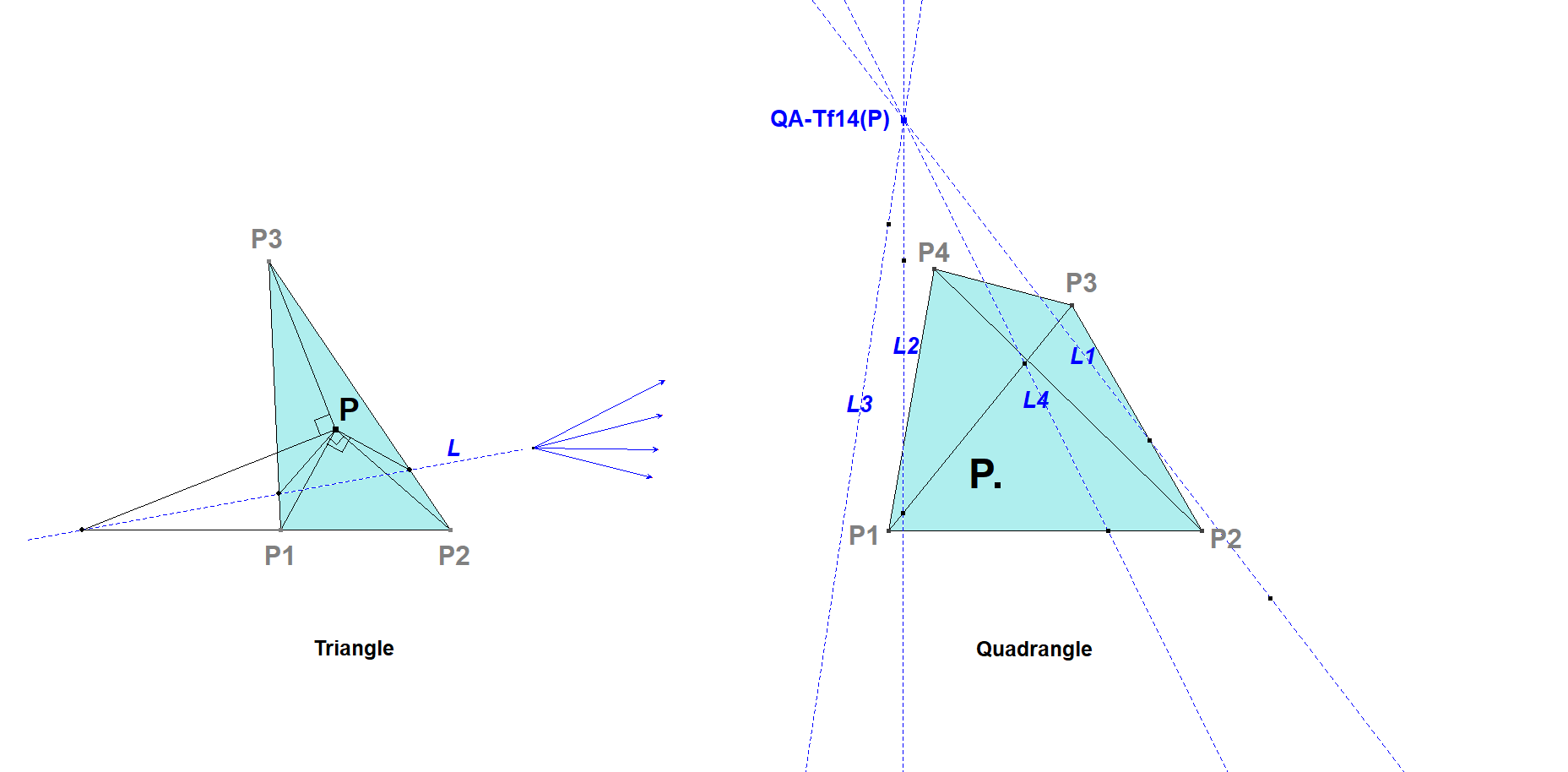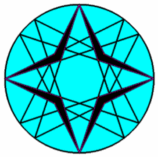QA-Tf14: QA-Orthotransversal Point
QA-Tf14 is a point to point trandsformation wrt a Quadrangle.
It is based upon the Orthotransversal transformation in a Triangle.
Definition Orthotransversal Line wrt a Triangle
Let ABC be the Reference Triangle and let P be a random point. The perpendiculars at P to AP, BP and CP respectively meet BC, AC and AB in three collinear points defining a line which is being called the orthotransversal (line) of P.
Definition Orthotransversal Point wrt a Quadrangle
The Orthotransversal lines of the 4 Component Triangles of a Quadrangle concur in a point, which is being called QA-Tf14 the QA-Orthotransversal Point.

Vu Thunh Tang mentioned this transformation at [59a]. See also [34], QFG-message #1233.
CT-Coordinates of QA-Tf14[(x:y:z)]:
(-2 a2 p r y2 z + 2 a2 p q y z2 + x2 (-p (a2 r – b2 r – c2 r) y – p (-a2 q + b2 q + c2 q) z) + x (-p (a2 r – b2 r + c2 r) y2 – p (-a2 q + b2 q – c2 q + a2 r + b2 r – c2 r) y z – p (-a2 q – b2 q + c2 q) z2) :
(a2 p – b2 p + c2 p) q y2 z + (-a2 p – b2 p + c2 p) q y z2 + x2 (q (-a2 r + b2 r + c2 r) y + 2 b2 q r z) + x (q (-a2 r + b2 r – c2 r) y2 + q (a2 p – b2 p – c2 p + a2 r + b2 r – c2 r) y z – 2 b2 p q z2) :
-(-a2 p + b2 p – c2 p) r y2 z – (a2 p + b2 p – c2 p) r y z2 + x2 (-2 c2 q r y – (-a2 q + b2 q + c2 q) r z) + x (2 c2 p r y2 – (a2 p – b2 p – c2 p + a2 q – b2 q + c2 q) r y z – (-a2 q – b2 q + c2 q) r z2))
Properties
- QA-Tf14(QA-P2) = QA-P4
- QA-Tf14(QA-P23) is a point in QA-L9.
- QA-Tf14(P) = CO-Tf3(P) wrt the conic defined by P1,P2,P3,P4,P, where P1,P2,P3,P4 are the vertices of the Reference Quadrangle (personal mail Benedetto Scimemi and see [34], QFG#1252).
- Consequently in a 5-Point configuration all versions of QA-Tf14(P) wrt the 5 Component Quadrangles coincide with CO-Tf3(P) when P is a point on the circumscribed conic of the 5-Point (5P-s-Co1), like described by Bendetto Scimemi in a personal mail and at [34], QFG#1252.
- Given a Pentangle {P1, P2, P3, P4, P5}.
- Let A1 = QA-Tf14 (P1) wrt {P2,P3,P4,P5}; similarly we define A2, A3, A4, A5.
- Let B1 = QA-Tf12 (P1) wrt {P2,P3,P4,P5}; similarly we define B2, B3, B4, B5.
- Then two pentangle {P1,P2,P3,P4,P5}, {A1,A2,A3,A4,A5} are inversely similar and the two pentangles {A1,A2,A3,A4,A5}, {B1, B2, B3, B4. B5} are homothetic with the center of the circumconic of {P1,P2,P3,P4,P5} as homothetic center. The circumconics of {P1,P2,P3,P4,P5}, {A1,A2,A3,A4,A5} and {B1, B2, B3, B4. B5} are similar and share the same center. See Vu thunh Tang at [59b].
- In a Pentangle the 5 versions of QA-Tf14(P) define a 5P-Conic. In a Hexangle (6-Point) the 6 versions of these 5P-Conics form a pencil of conics with 3 common points.
Estimated human page views: 352
